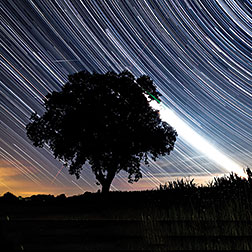- Number 393 |
- July 22, 2013
Illuminating microbial “dark matter”

There are more microbes in, on and around
the Earth than there are stars in the sky.
(Composition by Zosia Rostomian,
Berkeley Lab)
In cosmology, dark matter is said to account for the majority of mass in the universe. However, the number of microbes in, on and around the planet outnumbers the stars in the sky. Despite their profound influences on the most significant environmental processes, most of these microbes are still unknown. To learn more about these “microbial dark matter,” DOE Joint Genome Institute researchers led an international collaboration to fill in uncharted branches in the bacterial and archaeal tree of life. The team sorted 9,000 microbial cells isolated from nine locations around the world, applying single-cell genomics techniques to assemble and identify 201 distinct genomes. DOE JGI Director Eddy Rubin called the work, which appeared online July 14, 2013 in Nature, “a powerful example of how the DOE JGI pioneers discovery, in that we can take a high throughput approach to isolating and characterizing single genomes from complex environmental samples of millions of cells, to provide a profound leap of understanding the microbial evolution on our planet. This is really the next great frontier."
See the animation "Microbial Dark Matter: Illuminating the Tree of Life".
[Massie S. Ballon, 925.927.2541,
mlballon@lbl.gov]
